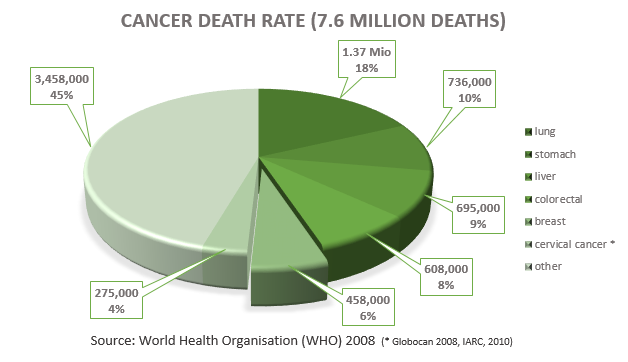|
|
|
|
|
|
|

|
| MTM Newsletter |
N° 2 - May 2013 | |
|
|
|
| |
|
Breast Cancer Information
Angelina Jolie an
inspiration for women to have genetic testing and mastectomies?
Scotland has already widened eligibility for breast cancer genetic
tests. Previously, one in five (20%) women were eligible for the
genetic test, now it is one in 10. It won’t be long and double
mastectomies are on the rise.
The World Health Organisation in
2008 stated that 11% of the population die of Breast Cancer, see
diagram below. To be born with a gene fault may increase the risk of
cancer, but does not mean one definitely gets cancer. It does mean,
however, that such an individual is more likely to develop cancer than
the average person. It also means that reducing the risk factor should
be a priority.

Aside from genetics, environmental factors increase cancer risks.
Cadmium, a highly persistent heavy metal, has been categorized as a
probable human carcinogen by the U.S. Environmental Protection Agency.
Primary exposure sources include food and tobacco smoke. Researchers
from the University of Wisconsin Comprehensive Cancer Center, Madison,
WI Hutchinson Cancer Research Center, Cancer Prevention Program,
Seattle, WA and affiliated organizations measured cadmium levels in
urine samples by inductively coupled plasma mass spectrometry and
conducted interviews by telephone to obtain information on known
breast cancer risk factors. They noted a statistically significant
increase in risk with increasing cadmium levels. (1)
In our study, published in 2007, we determined a remarkable
difference in metal accumulation in malignant breast tissue compared
to healthy breast tissue. (2) A highly significant accumulation of iron
(p<0.0001), nickel (p<0.00005), chromium (p<0.00005), zinc
(p<0.00001), cadmium (p<0.005), mercury (p<0.005), and lead (p< 0.05)
was found in the cancer samples when compared to the control group.
This pathological accumulation of transition metals in breast tissue
may be closely related to the malignant growth process.
A
Lithuanian study concluded ‘exposure to cadmium appears to be
associated with breast cancer. Higher concentration of cadmium in
breast cancer tissue and cancer patients’ urine, assessing cumulative
cadmium exposure from all sources including smoking and diet, supports
a possible relationship between cadmium and breast cancer. (3)
As a
preventative measure, EDTA chelation comes to mind. For more
information:
http://www.microtraceminerals.com/en/chelation-newsarticles/edta
And
http://www.microtraceminerals.com/en/metals-and-disease-research/cancer/breast-cancer
We wish you all the
best. If you find this newsletter informative, let us know.
E.Blaurock-Busch and teamReferences:
|
1) |
Jane A. McElroy, Martin M. Shafer, Amy Trentham-Dietz, John M.
Hampton, Polly A. Newcomb. Cadmium Exposure and Breast Cancer
Risk. JNCI J Natl Cancer Inst. Volume 98, Issue 12 Pp.
869-873. |
|
2) |
Ionescu JG, Novotny J, Stejskal V, Lätsch A, Blaurock-Busch E,
Eisenmann-Klein M. Increased levels of transition metals in
breast cancer tissue. Neuro Endocrinol Lett. 2007 Oct;27 Suppl
1:36-9. |
|
3) |
http://repository.peerproject.eu/jspui/bitstream/123456789/8640/1/PEER_stage2_10.1007%252Fs10549-010-1007-8.pdf
|
|
|
|
|
|
| |
|
|
| |
|
|
|
